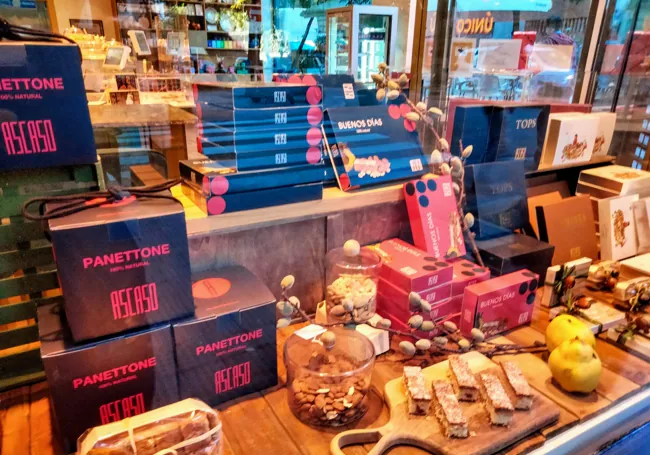Russian cake: Spain's well kept secret for 50 years
The exquisite 'Pastel Ruso', which has no real connection with Russia, is little known in Spain despite its apparent royal origins
Alekk M. Saanders
Monday, 22 January 2024, 14:20
The Pastel Ruso ('Russian Cake' in English) in an exclusive Spanish dessert with a history. Despite the name, the pastry is not of Russian origin, but was created for Andaluía-born Eugénie de Montijo, the wife of Napoleon III and Empress of the French.
A surprise for the Tsar
In was at the time of the 1867 Paris Exposition that Eugénie de Montijo came up with the idea of preparing a special cake to surprise the Russian Tsar. According to the legend, the Empress organised a banquet for Tsar Alexander II and commissioned Spanish chefs to prepare a special cake for dessert. They ended up creating a cake made of ground hazelnuts and almonds with a praline butter filling.

Alexander II was so impressed with the flavour of this dessert that he asked for more and more, which led to it becoming known as the Pastel Ruso. Apparently, the Tsar even asked for the recipe, but the Spanish cake did not gain such popularity in Russia. The Pastel Ruso also fell into oblivion in France.
The sweet rebirth
It was in 1974 that the cake was revived in Spain thanks to Vicente Ascaso Martínez, third generation of the Ascaso confectionery firm, founded in Huesca (Aragon) in 1890. Fifty years ago, Vicente decided to get his hands on the original Pastel Ruso recipe. He travelled to the south of France and read numerous culinary books, eventually creating his own master recipe.
"In 1974, after much research, Pastelería Ascaso introduced a new cake among our creations. Over these decades, the Pastel Ruso has become our most popular speciality. It is made of hazelnuts, almonds, egg white, praline foam and Ascaso's secret touch," Vicente Ascaso Martínez told SUR in English.
Pastel Ruso has become an iconic Spanish dessert, alongside Ponche Segoviano and Tarta de Santiago. Word of mouth has led Ascaso's Russian cake to be considered one of the most exquisite Spanish desserts, albeit less known in other parts of the country.
Vicente Ascaso Martínez said that some confectioners have copied his recipe. Nevertheless, some versions are a sponge cake filled with merengue, which is very different from the original version that contains no flour at all (so is suitable for coeliacs). Unsurprisingly, for the authentic taste, gourmets always go to the Ascaso bakeries located in Huesca, Zaragoza and Madrid. The exclusive dessert is also sold at El Corte Inglés.
Ascaso and its Pastel Ruso is an excellent example of how a superior product can be a great business breakthrough
The Pastel Ruso can be ordered from Ascaso's website and delivered to any corner of Spain. Incidentally, though the dessert is totally preservative-free, it stores well, allowing it to 'travel' far, and this is also the secret of its success. At a temperature between 0º and 6º the shelf life is two months. The dessert has been awarded the "C" C'Alial for Food Quality by the Government of Aragon. Ascaso and its Pastel Ruso is an excellent example of how a superior product can be a great business breakthrough.
An Andalusian noblewoman
Doña María Eugenia Ignacia Agustina de Palafox y Kirkpatrick (known later as Eugénie de Montijo) was 19th Countess of Teba, 16th Marchioness of Ardales, both municipalities that are now part of Málaga province. The surname Kirkpatrick hints at her British ancestry.
Eugénie was born in Granada in 1826 to a prominent Spanish nobleman, Don Cipriano de Palafoxa y Portocarrero, three times grandee of Spain, and Marie de Grevigner, daughter of the Scots-born William Kirkpatrick of Closeburn, who served as United States Consul in Málaga.
Eugénie was educated in France, Spain, and England. She grew into a strong and physically courageous girl who devoted herself to horseback riding and other sports. It is believed, once she was saved from drowning and twice, being a very romantic nature, she attempted suicide after love disappointments.
There is a legend that Eugénie fell head over heels in love with the 17th Marquis of Alcañices, but was betrayed and, believing her life to be broken, she decided to take the tonsure. However, the abbess of the convent supposedly dissuaded her, saying: "You are so beautiful that you seem born to sit on a throne."
In 1834 Eugénie left Spain for France and then travelled to Bristol to study English. She met Prince Louis Napoleon when he was president of the Second French Republic. It is reported that when Napoleon asked about the way to her heart, he received the answer - "Through the chapel, sire."
After becoming emperor, Napoleon III officially announced his engagement on 22 January 1853. Within a week Napoleon III and Eugénie de Montijo were married, first in a civil ceremony, and on 30 January a more solemn religious ceremony took place, not in a chapel but in the main cathedral of Paris - Notre-Dame.